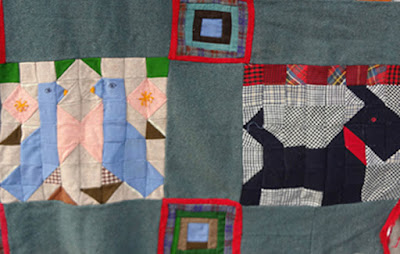Figurative crib quilt
from a 1929 McCall's needlework catalog
McCall’s Designs for Needlework and Decorative Arts.
No real name:
"Design for Child's Picture Patch Quilt"
One could buy the pattern transfers for 50 cents.
Karey Bresenhan Collection
And many people did.
The pattern doesn't tell us but it looks like a circus quilt with a circus train engine, a giraffe, an elephant and a tiger. The human figures may be Chinese acrobats and perhaps in the lower left here clowns with pointy hats.
Pierrot figure with a cone-shaped hat.
A little insidious racial stereotyping
Chinese acrobats in a 1906 poster
Lynn Evans Miller Collection
A fancy border and edge
From Karen Alexander's collection
The McCall's pattern gave you six blocks.
See the diagrams at Q is for Quilter
And you could make up your own if you wanted a bigger quilt.
The McCall's pattern gave no designer's name but it may have been the work of Ruth Oppenheimer and Wilhelmine Haas who a year or so earlier published a similar pattern in Needlecraft Magazine (March, 1928): "For the Very Young Comes Patchwork in a New Form"
Oppenheimer & Haas seem to have specialized in these gridded
puzzle patchworks of animals and people.
Figures dressed in the aprons and large hats traditionally worn
in Normandy, France.
There was a mid-20th century fashion for classifying the people of the world by racial features and traditional costume. The artists seem to have been fond of their Chinese stereotype.
A figure in Chinese costume, a kite and a Chow dog.
BlockBase #940.42 at the top right
Why Chinese? Marin Hanson, Curator at the International Quilt Study Center and Museum, gives the question some thought in this article: "Exotic Quilt Patterns and Pattern Names in the 1920s and 1930s". See a PDF here:
Similar idea: Circus animals on train cars
with the square wheels.
I haven't been able to find a thing out about who Ruth Oppenheimer and Wilhelmine Haas were, perhaps free-lance writers on needlework.




















No comments:
Post a Comment